Exploring Lucerne – What You Can’t Miss
In the last post from this Adventures Abroad hiking/walking tour of Switzerland we arrived in the beautiful city of Lucerne and joined city native Yvonne Bieder on a walking tour of the older parts of the city including the two famous covered bridges. In this post we’ll continue exploring Lucerne by visiting a few more must see sights including the city walls, the Lion of Lucerne and the wonderful Rosengart art gallery. Afterwards I’ll make some restaurant recommendations. Please join us in what promises to be a fun time.
You spend three nights at the Waldstatterhof Hotel at the conclusion of the tour which leaves plenty of free time for exploring Lucerne on your own. Much of what I am writing about today we experienced on a quiet Sunday morning before boarding the train to Zurich.
The Lion of Lucerne
The first thing we’ll do is cross the river to the old part of the city and head towards the spires of St. Leodegar church which is built on the spot where the first chapel was erected way back in 735 as we learned in the last post. This was the spot that the angel we saw in one of the panels of the Chapel Bridge was pointing to and it is considered the heart of Lucerne. Here is a photo of the church and the Grand National Hotel where Cesar Ritz got his start as a hotel manager, which I got off the Lucerne tourism website.
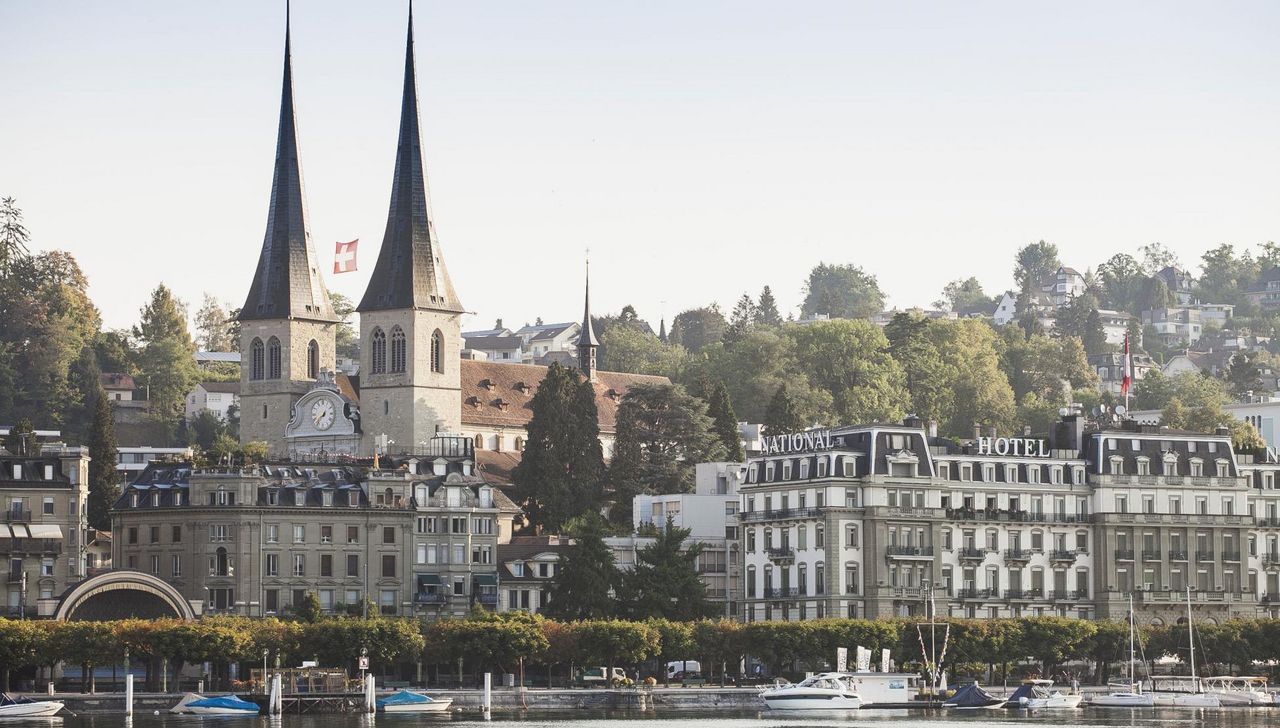
However, as it’s Sunday we won’t be going inside, but rather continuing up the Lowenstrasse to the most famous monument in the city, The Lion of Lucerne. This huge statue of a dying lion was carved out of the side of a sheer rock face by Danish artist Bertel Thorvelsen in 1821 to commemorate an event that happened in Paris in 1792. On August 10 of that year Republican forces stormed the palace of Louis XVI in the Tuileries Garden in the most decisive act of the French Revolution. Louis was protected by about 1,000 Swiss guards who were mercenaries known for their loyalty and courage. They proved it that day by fighting to the death to protect the king, ultimately overwhelmed by superior force. They were wiped out almost to a man. One of the officers of the Swiss Guards who was not there commissioned the work to honour his fallen comrades and today over 1.4 million people a year visit it.
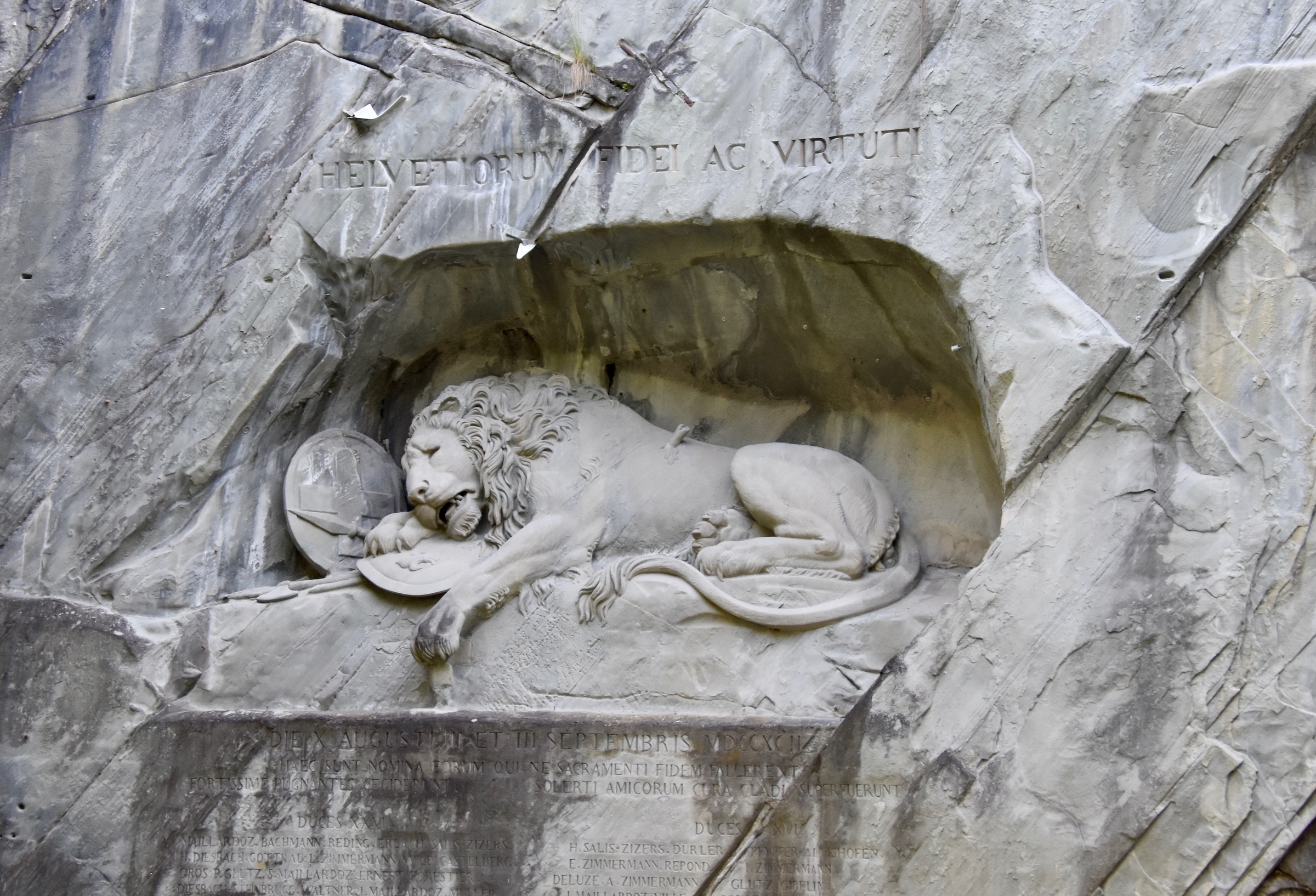
It’s a compelling work of art to see and we were very lucky to be the only ones there. Not more than a few minutes after taking this picture a number of tourist buses pulled up and the place was overrun almost instantyly.
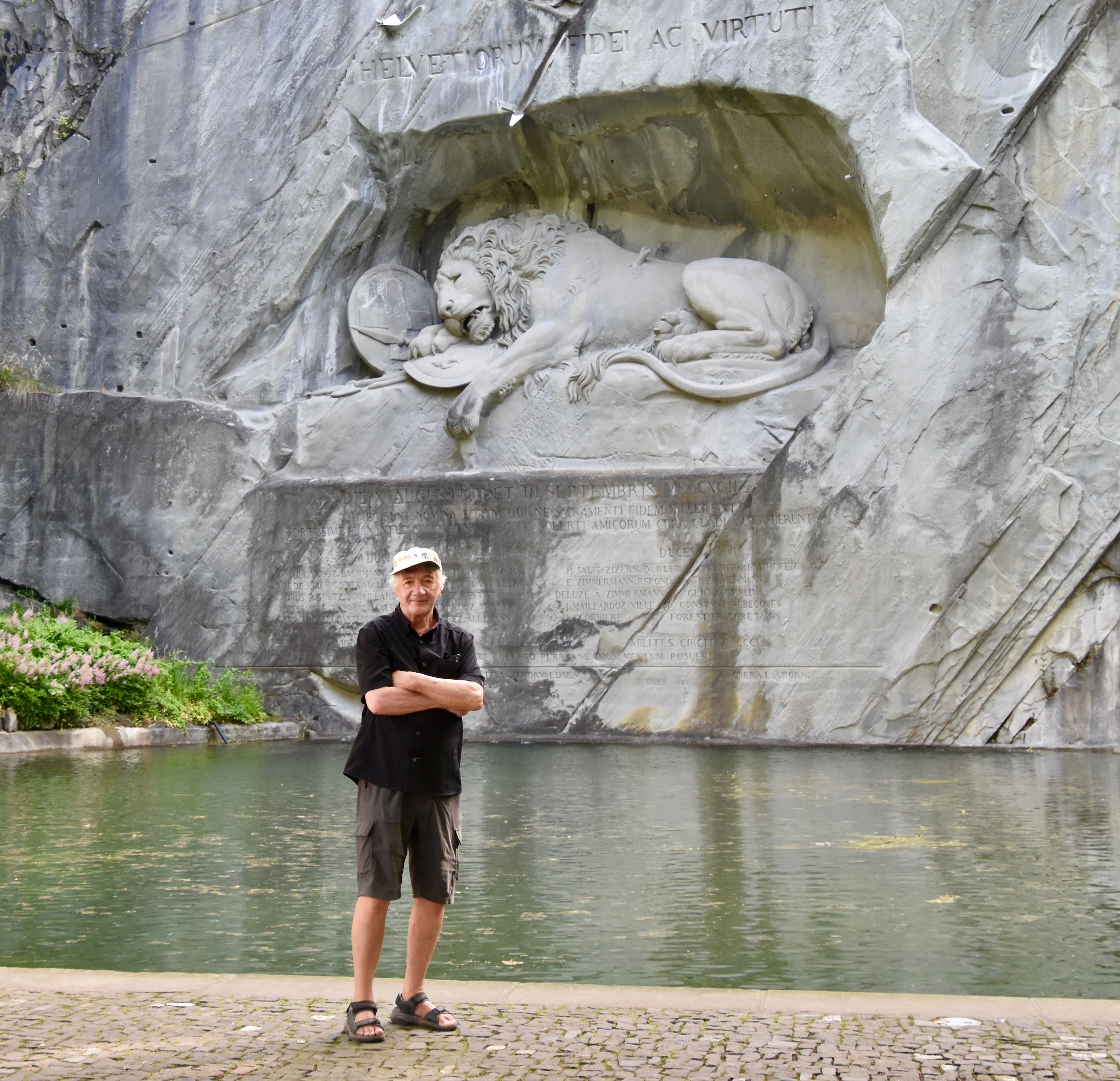
The monument will be scaffolded from March through May 2023 for repairs so wait until at least June to plan a visit.
The Musegg Wall and Towers
In the previous post I gave a brief history of Lucerne which I won’t repeat here. What I didn’t mention is that the city has a famous wall, parts of which date back to the 14th century and upon which stand nine completely different towers. The Musegg Wall as it is properly called was saved from the destruction that most other medieval city walls underwent in the 18th and 19th centuries in the name of ‘modernization’. The wise decision to preserve rather than to raze what had been part of the city’s integral identity for many centuries was a wise one as the wall and towers have become one of Lucerne’s top tourist attractions. Beginning in the 19th century artists like J.M.W.Turner were drawn to the city to paint and sketch the wall.
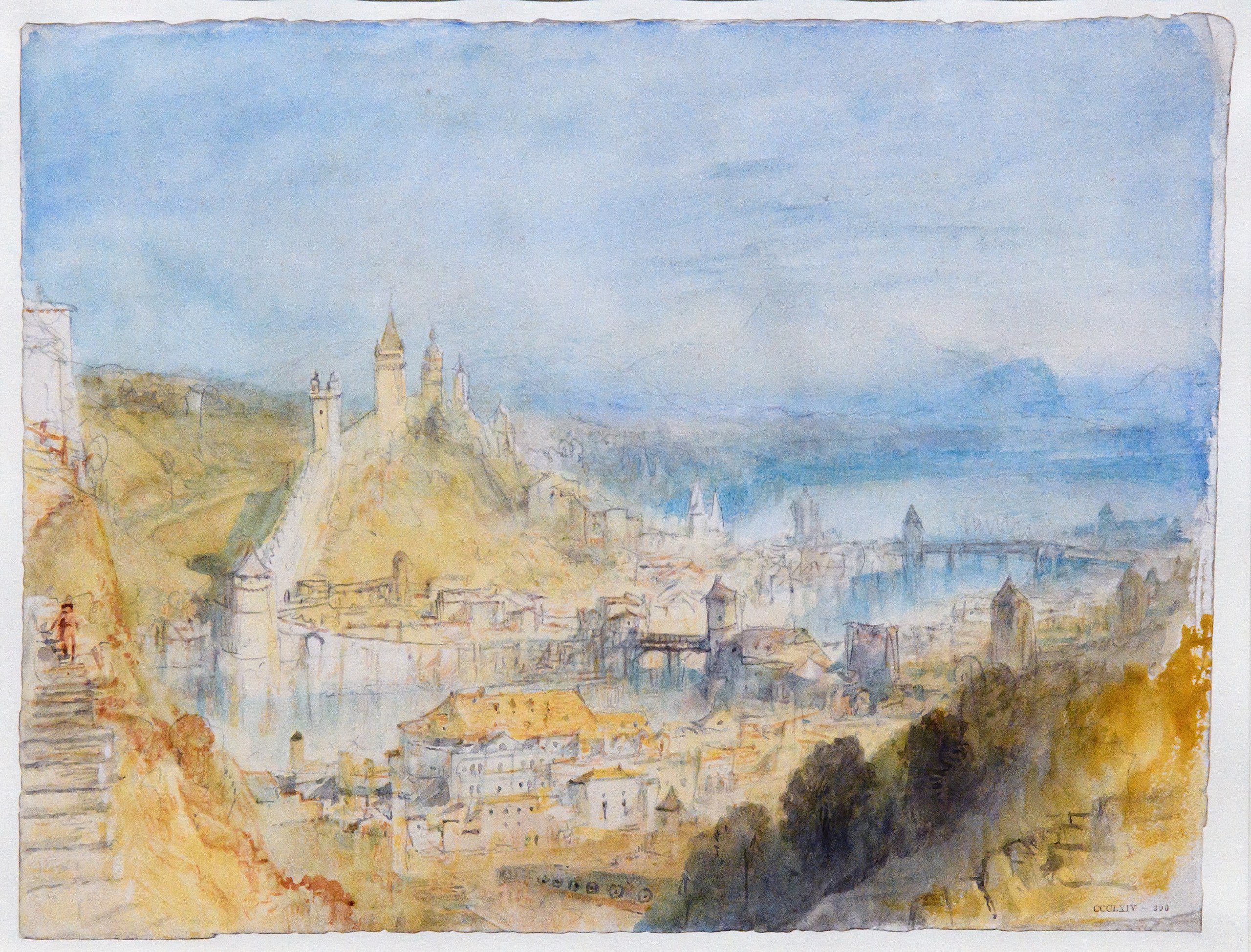
From the Lion of Lucerne we’ll continue exploring Lucerne by walking a bit downhill to get to the Roof Tower which marks the end of the wall on the side closest to Lake Lucerne. From here you can get a good look at the walls from the outside. This is the clock tower on the left and the Watchtower on the right.
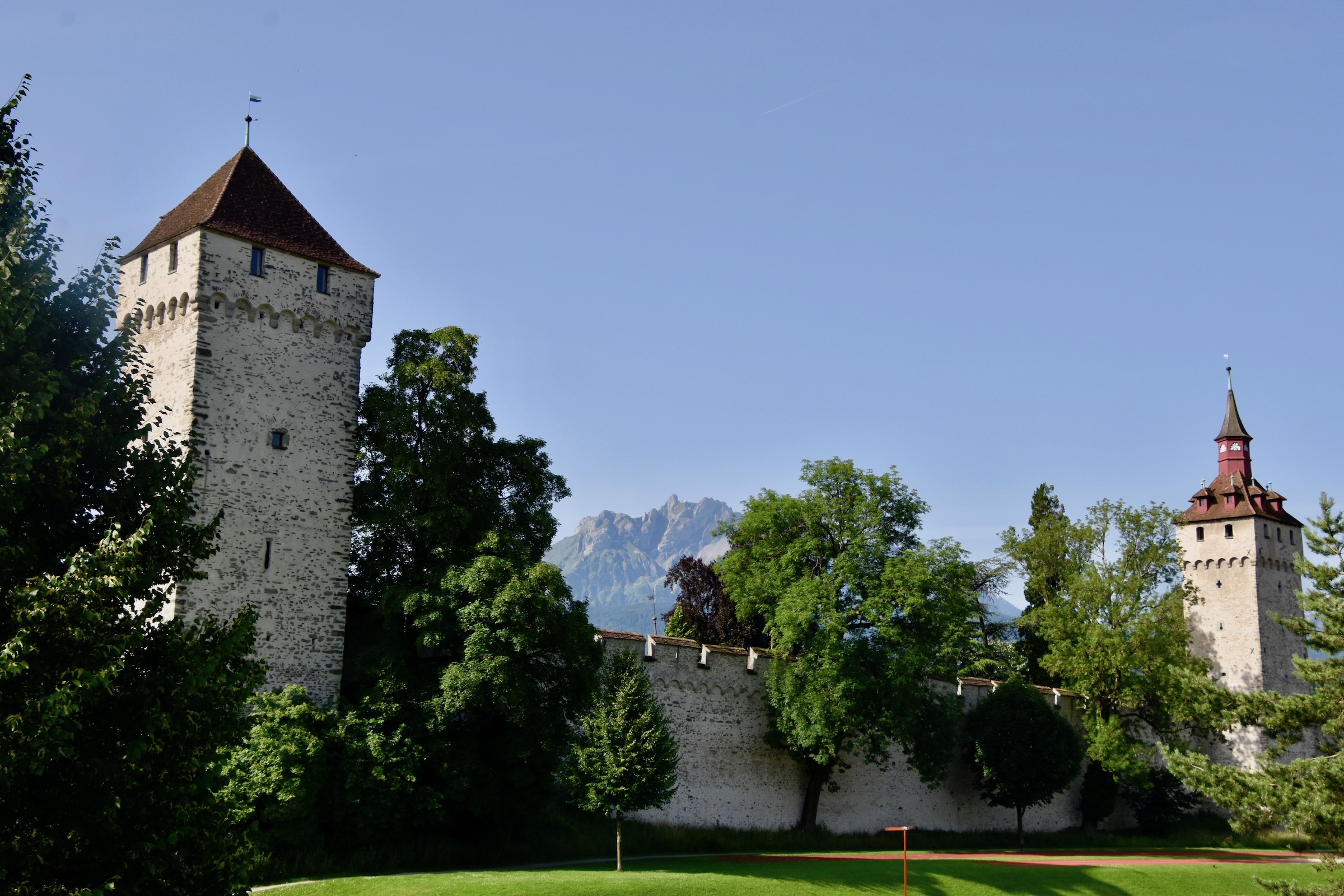
And further along this view of the Watchtower and the Leugisland Tower, the latter of which is the tallest of the nine.
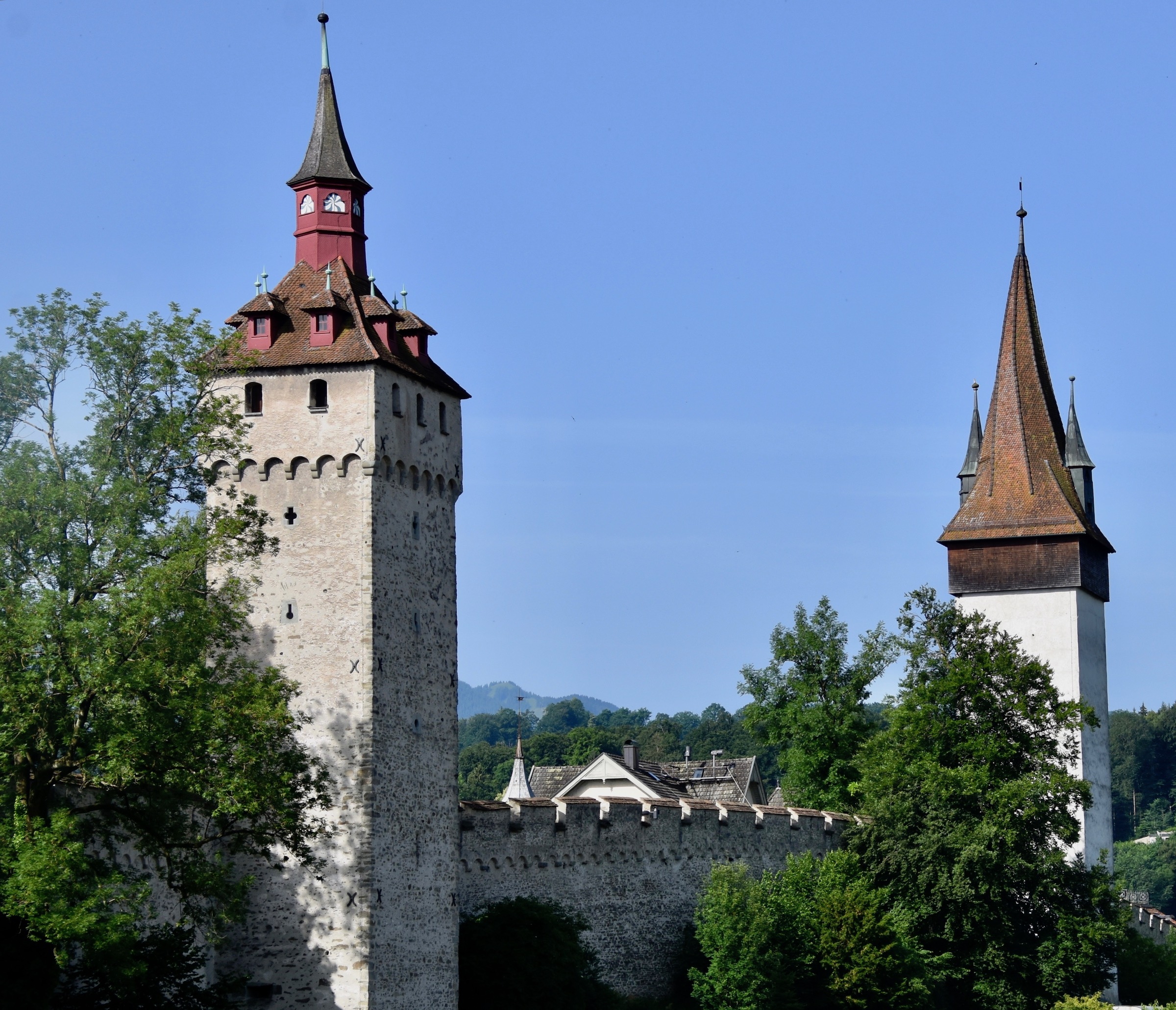
There are a number of places you can access the walls. This is the coat-of-arms found at the entrance to the Schirmer Tower which is one of four towers open to the public and the first place you can access the walls from the side closest to Lake Lucerne.
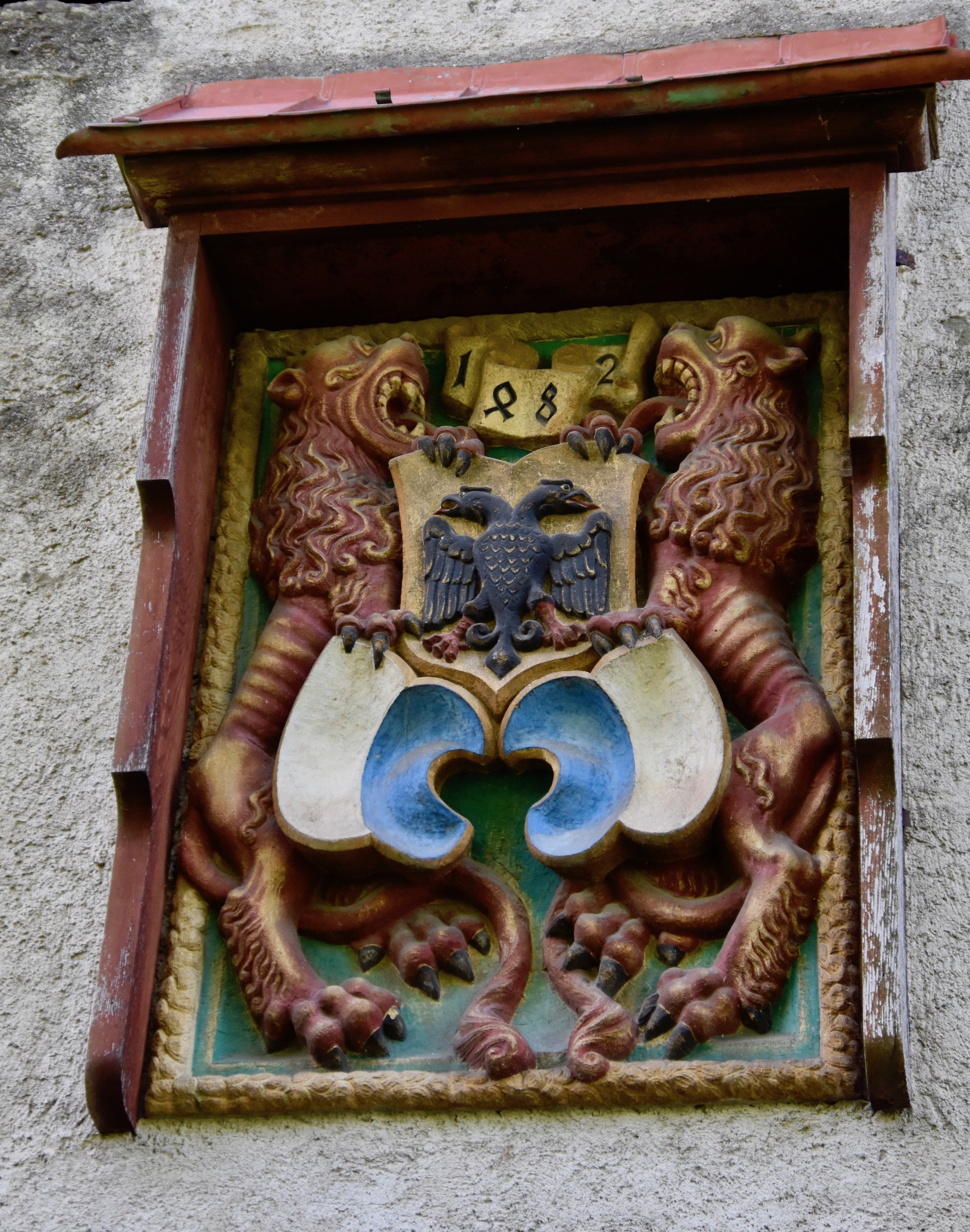
This is a view of the walkway that runs from the Schirmer Tower to the Clock Tower.
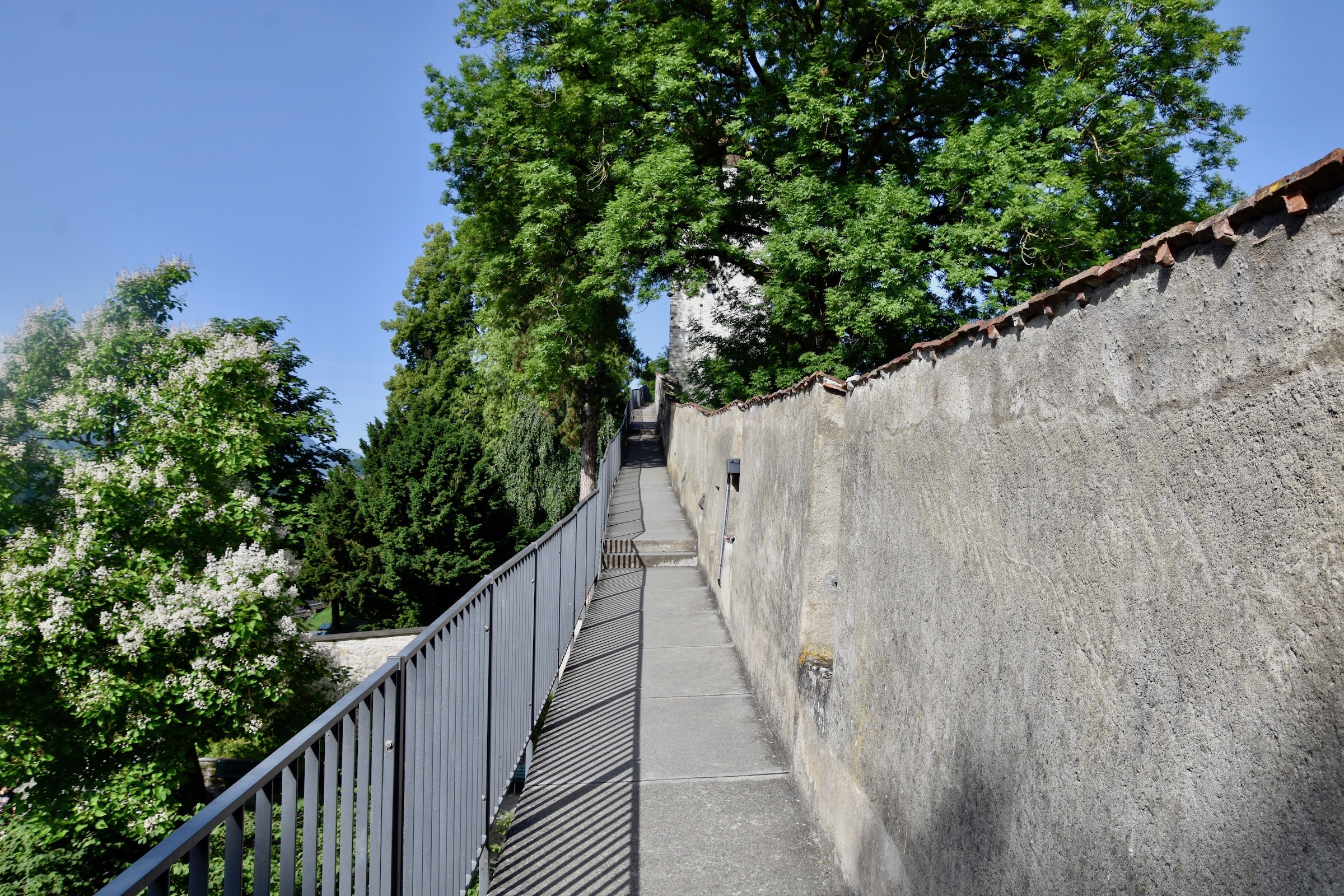
There are great views of Lucerne from this walkway and provide reason enough to visit the wall. Note the old entrance to the railway station from where we started exploring Lucerne in the last post.
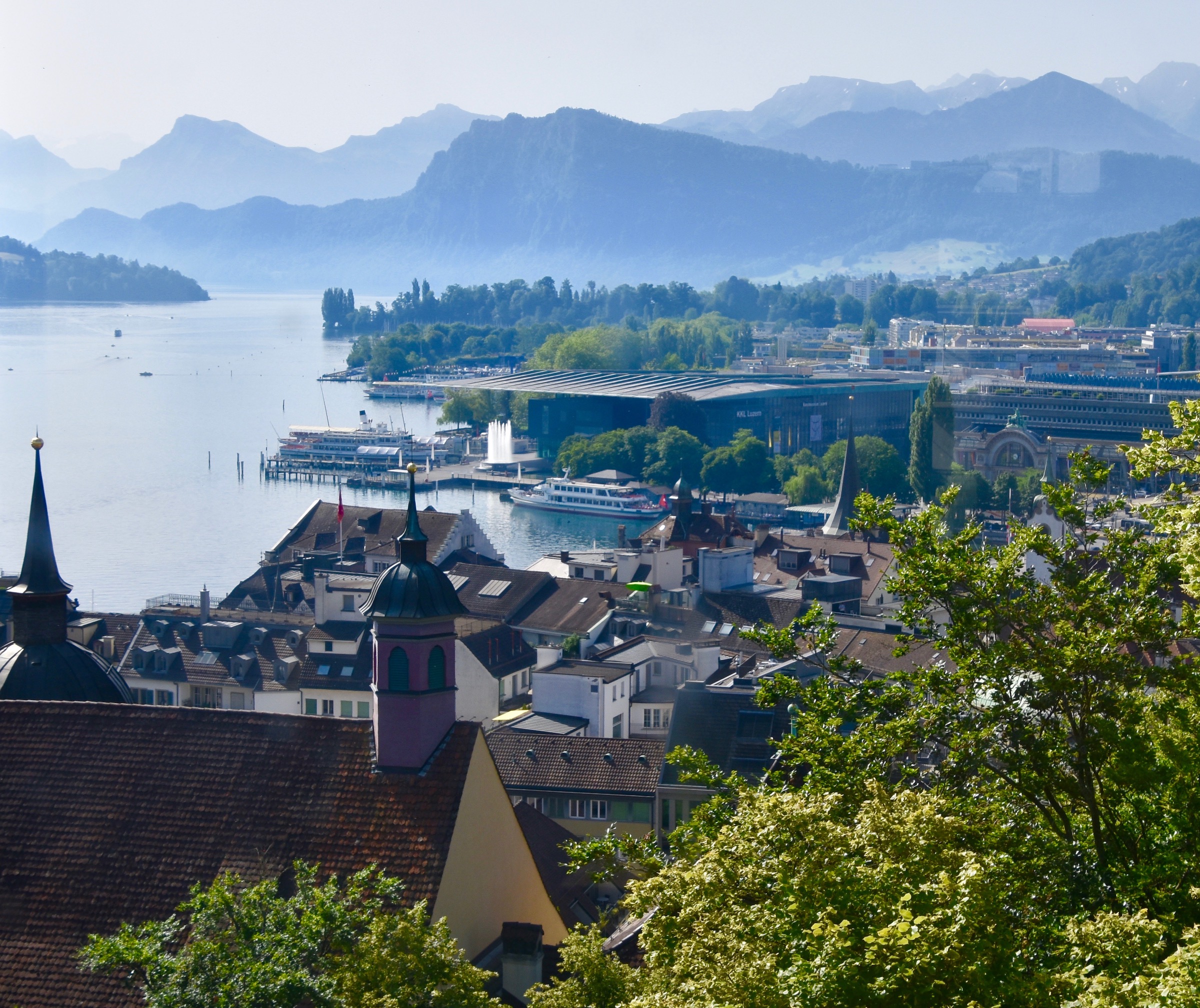
This is the approach to the Clock Tower.
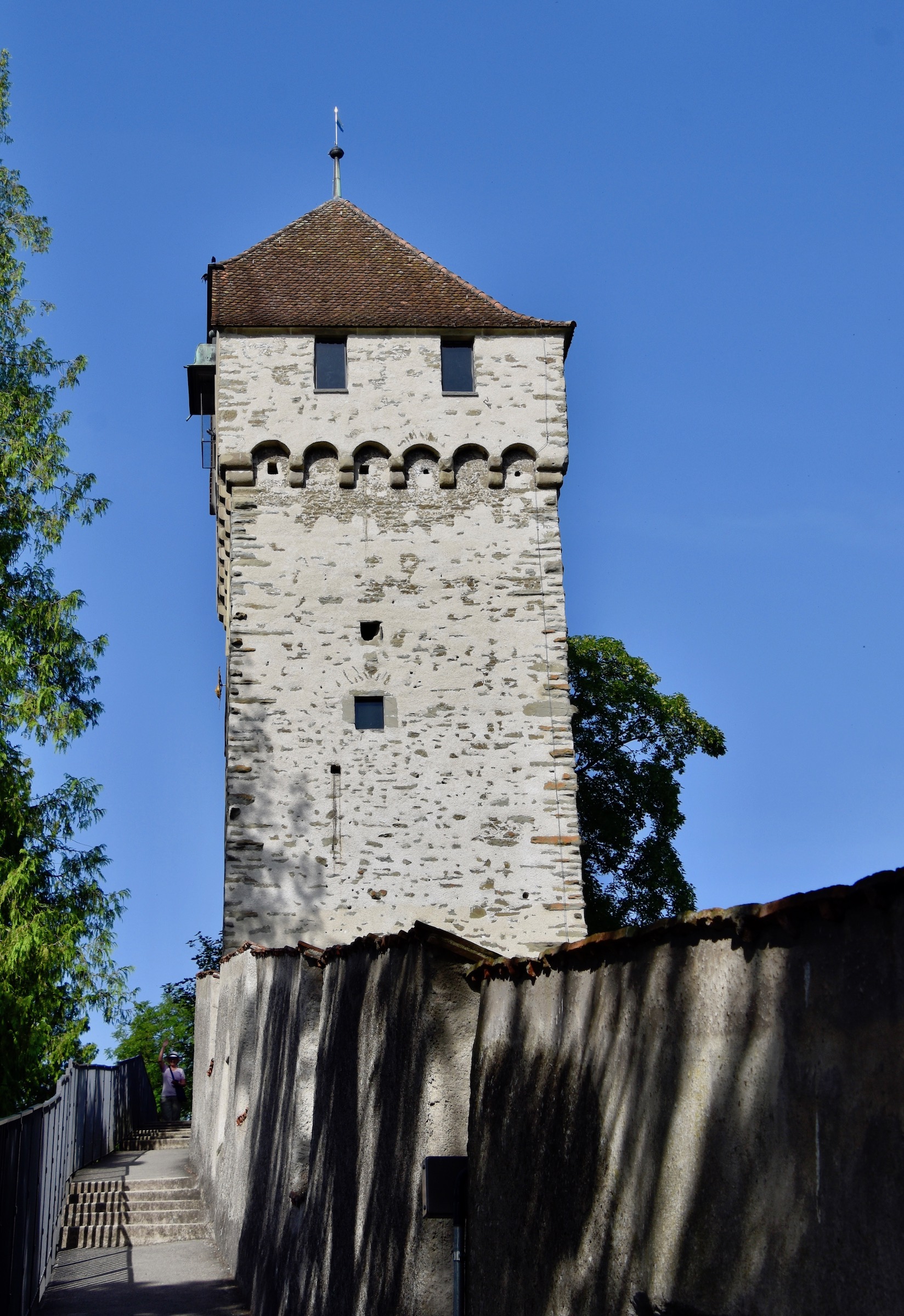
Unfortunately you cannot really see the very unusual painting on the front of the Clock Tower which is another Lucerne trademark. This is the view from just below the Clock Tower from inside the walls with the two so-called ‘wildmen’ seeming to hold up the clock face while also holding the shield of Lucerne.
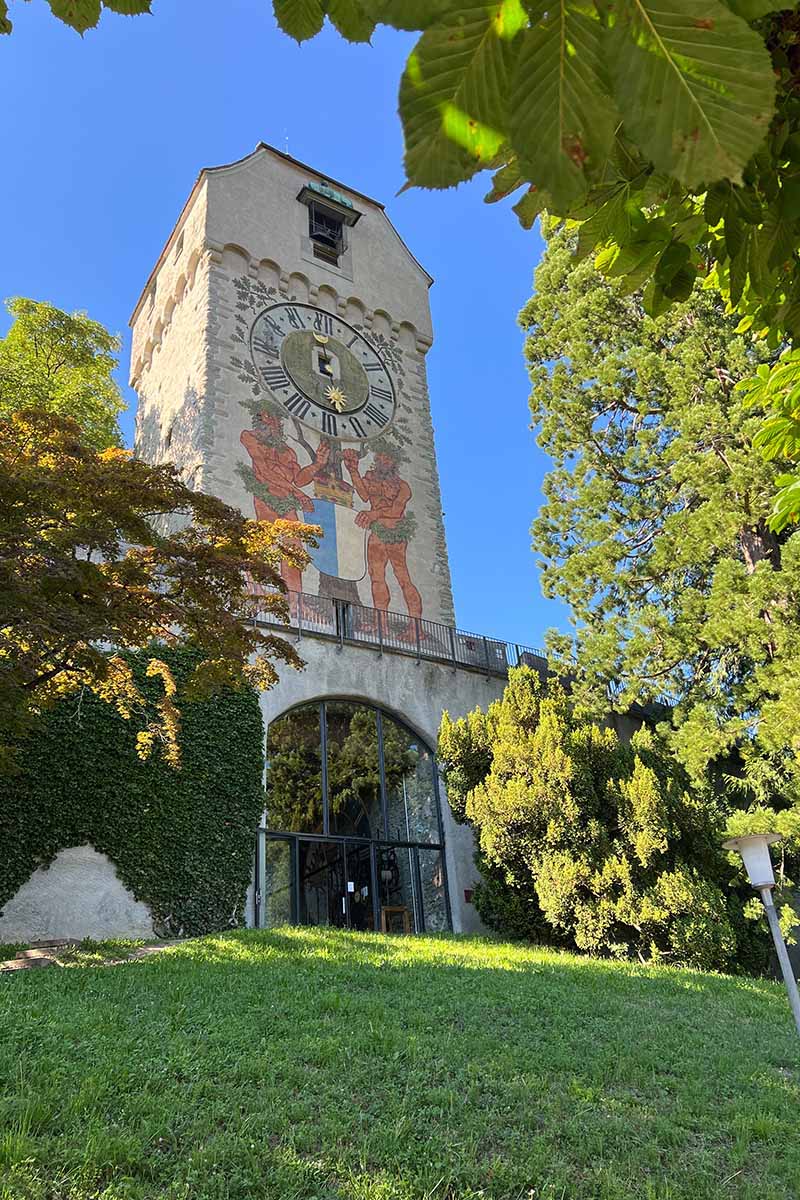
It is definitely worth climbing the Clock Tower to get even better views of Lucerne and its surroundings. This is looking back along the wall towards St. Leodegar with three of the wall’s towers in view.
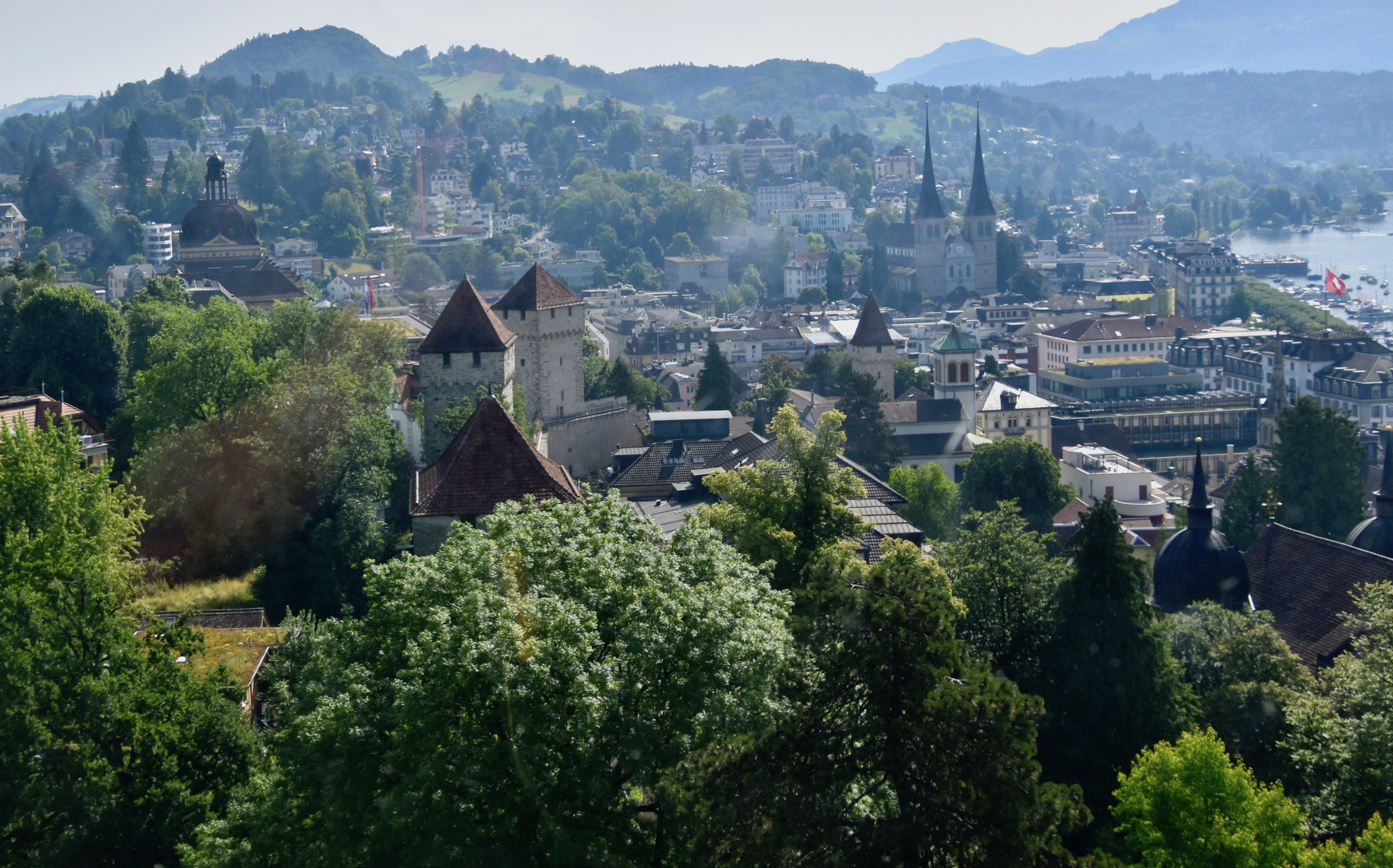
Not far past the Clock Tower the portion of the walls that you can walk ends and you come out on the outside of the walls to continue your walk. That is the Mannliturm, the eighth tower, that Alison is heading towards. Note the fence on the right hand side.
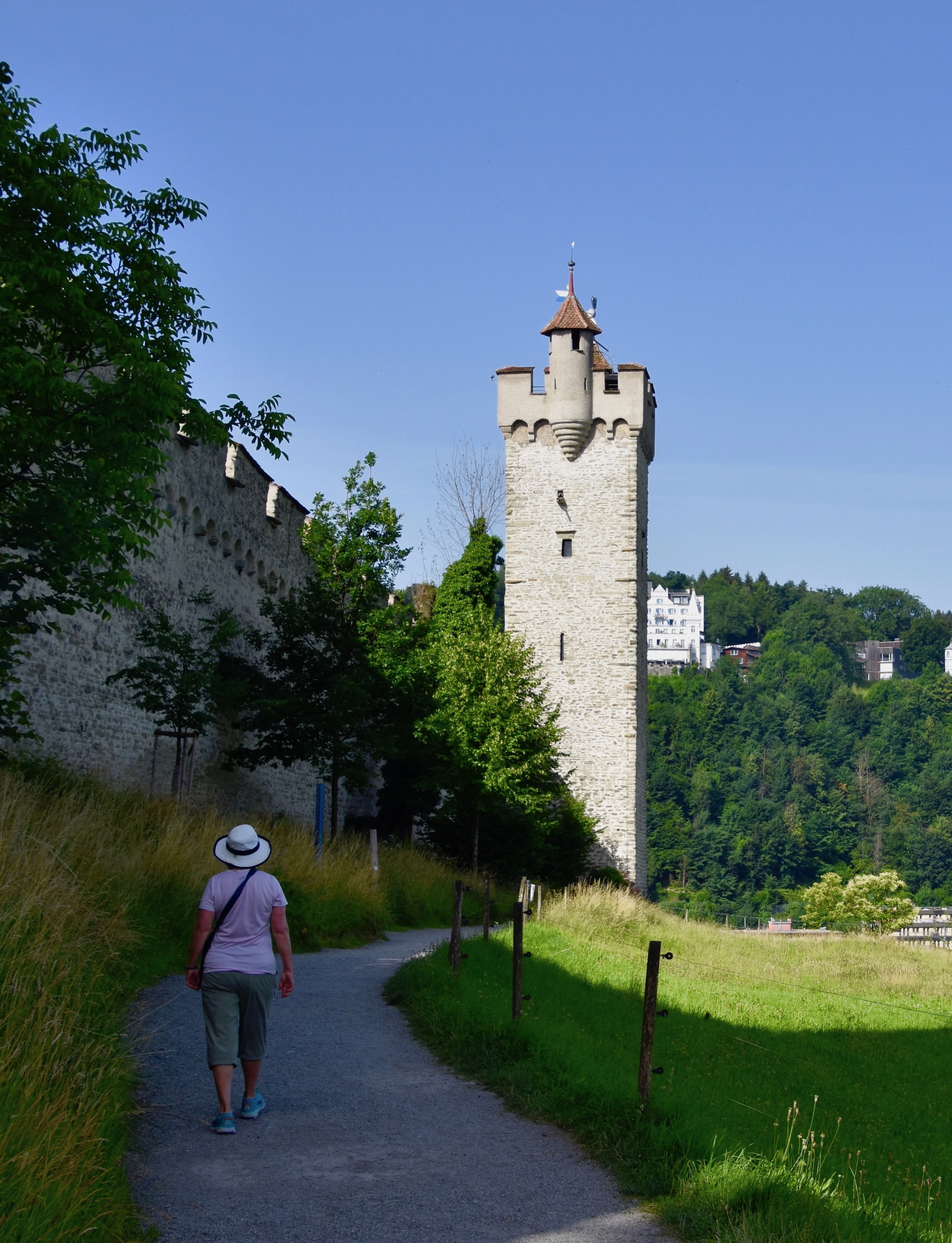
The fence is there to keep in these highland cattle that are a long way from their traditional Scottish home. I have seen many different breeds of cattle during this trip, but this is the first time I have seen this breed.
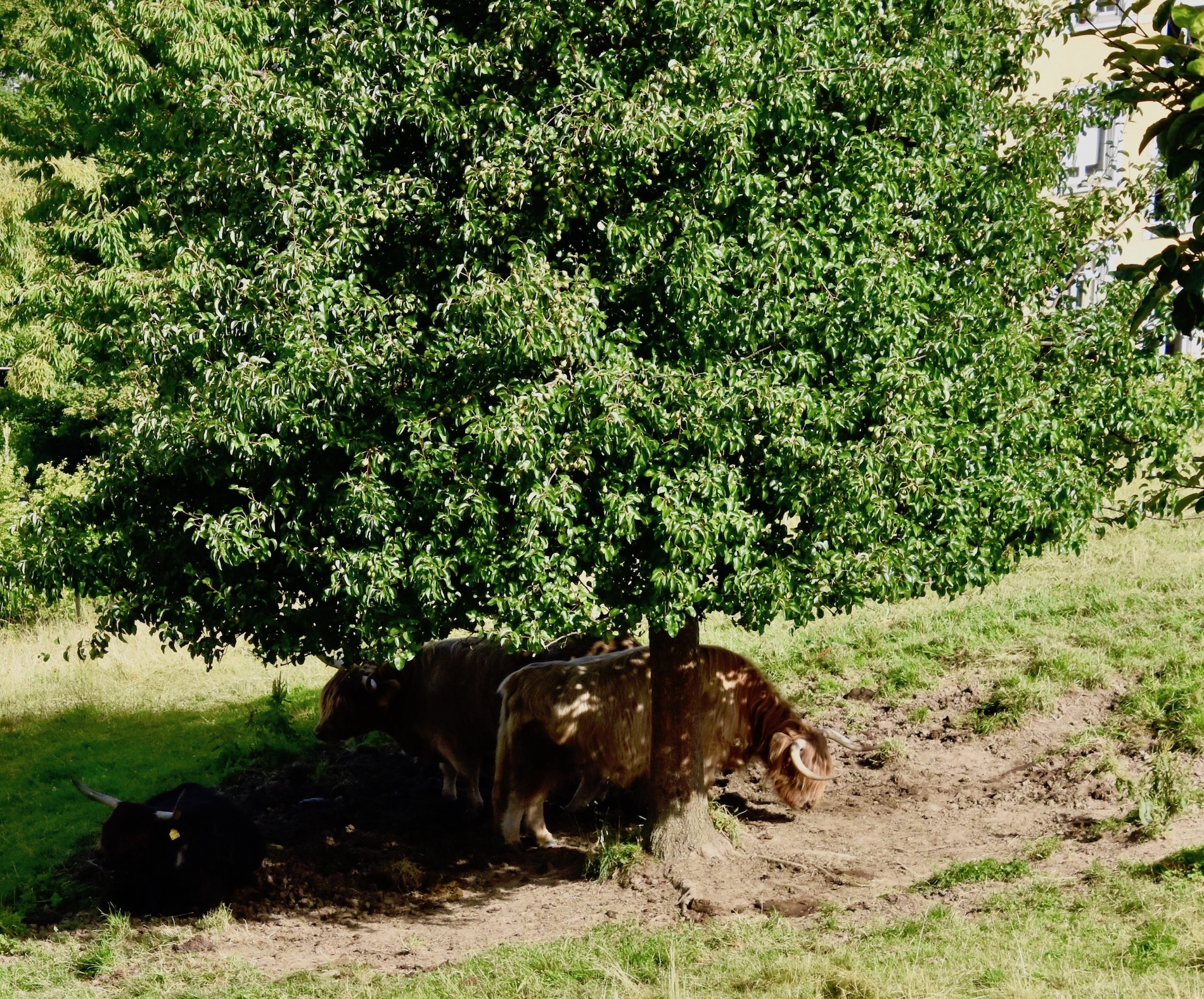
Not far past this spot the walls descend toward the Reuss River and the final tower, the Nölliturm or Round Tower which is on the river bank.
Exploring Lucerne – The Rosengart Collection
If perchance it should rain during your stay in Lucerne then you will have the perfect opportunity to visit what until only two decades ago was one of the largest private collections of modern art in the world. Siegfried Rosengart was a German art dealer who was an intimate of Picasso, Klee and many other early 20th century artists. He moved to Lucerne in 1920 and together with his daughter Angela ran one of the most influential art dealerships in the world, handling works by virtually every well known artist of the day as well as those of the Impressionists and Post-Impressionists. Between them they amassed hundreds of works for their own collection. After her father’s death Angela created a foundation with the intention of putting their collection on display for the public. In 2002 the Rosengart Collection opened in a former Swiss bank building and it is now a must visit site for anyone with an interest in late 19th and 20th century art.
I could easily write an entire post about the Rosengart Collection as I did with the Kunstmuseum in Basel, but I will limit my musings to only a few works starting with this Picasso, one of thirty-two on display on the ground floor.
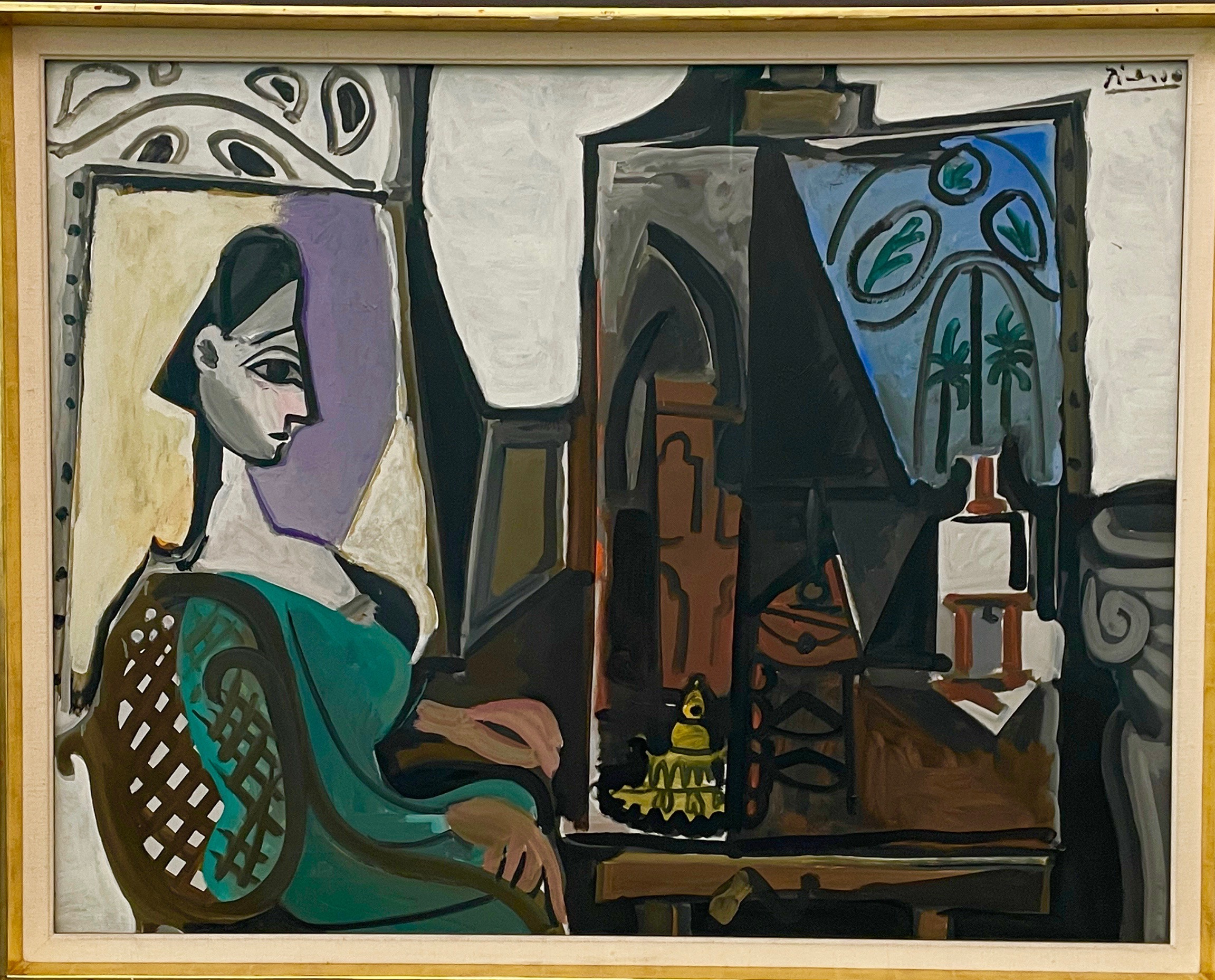
Whether Picasso was a notorious misogynist or just a jerk is open for debate, but there is no doubt that Jaqueline Roque was his most fervent admirer. She married the 79 year old artist when she was only 34 and stayed with him until his death in 1973. He painted her more than 400 times of which this and another are on display in Lucerne. Picasso also painted or sketched Angela Rosengart on a number of occasions and you can see on display as well. Along with the paintings and sketches there are dozens of photographs of Picasso in various settings. For anyone who is a Picasso devotee the Rosengart Collection is an important place to visit.
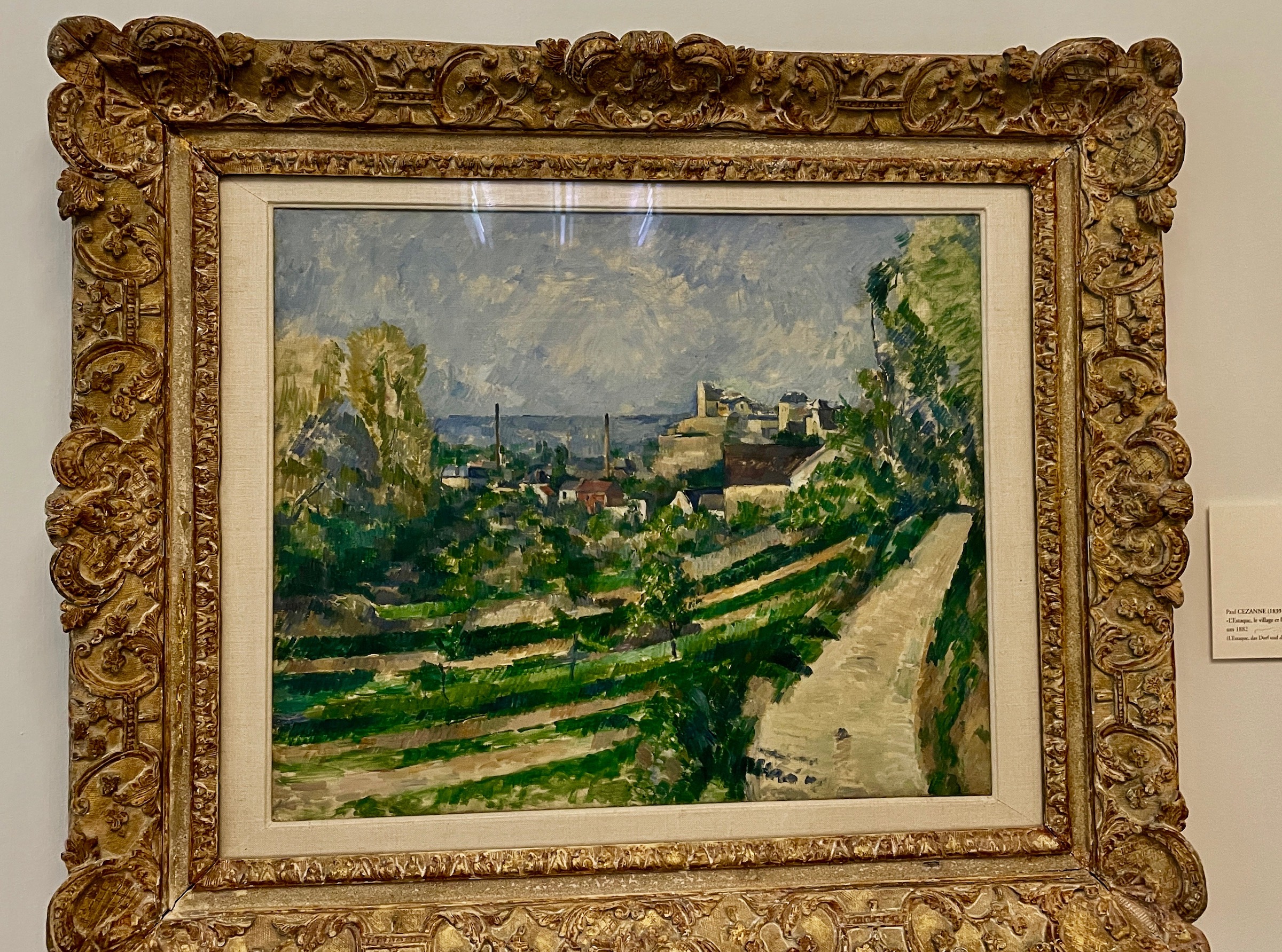
The small village of L’Estaque, just outside Marseilles, was one of Paul Cezanne’s favourite places to paint and the Rosengart Collection has this version on display.
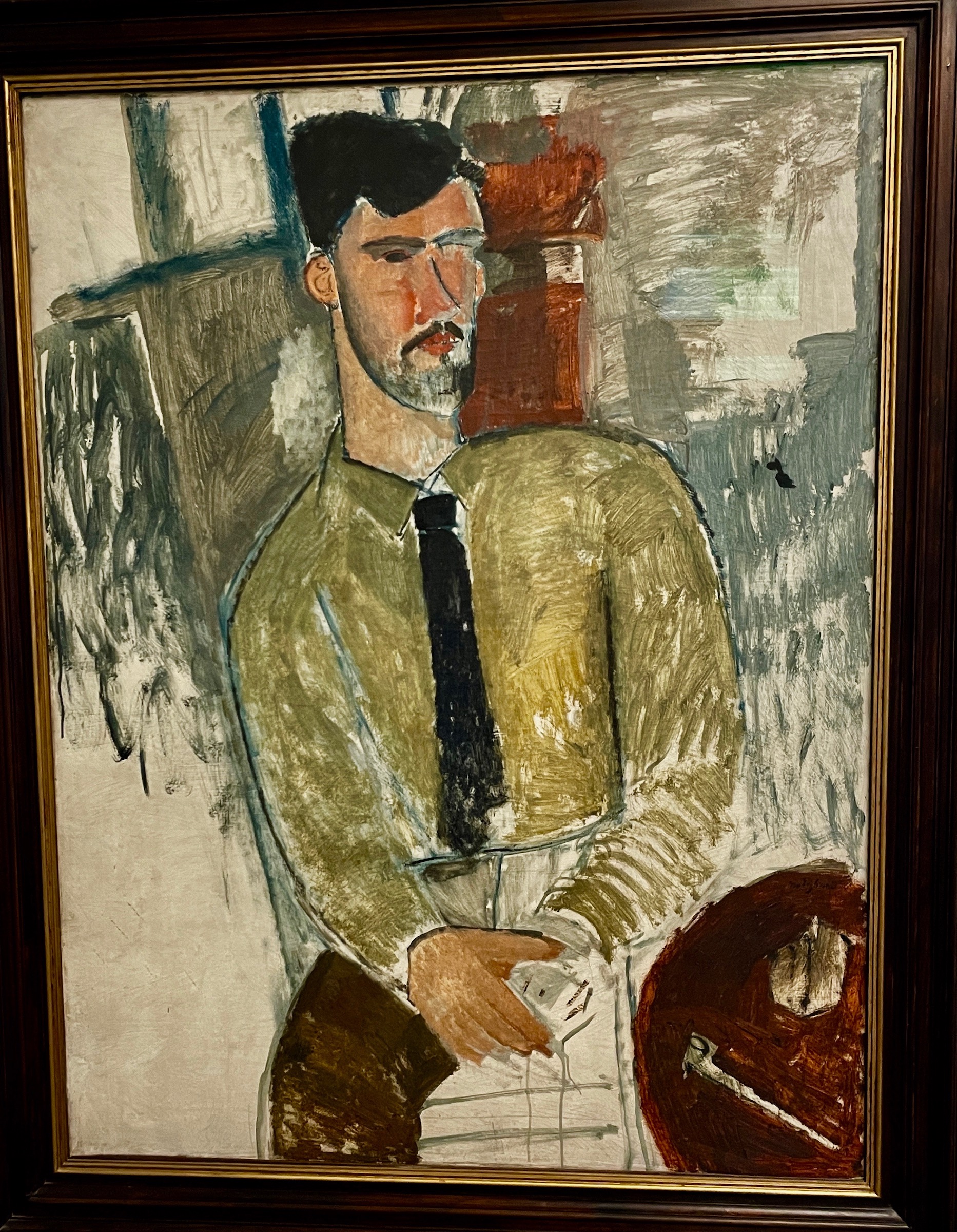
Amedeo Modigliani became one of my favourites of modern artists ever since first looking at his works in art books in the school library a long time ago. His method of portraiture is totally unique and his works now fetch astronomical prices at auction – e.g.Nu Couché sold for $170 million in 2015. Sadly, like Van Gogh, his works were reviled during his short lifetime and he died destitute. His widow Jeanne Hébuterne, eight months pregnant, threw herself out of a window the day after his death. They are buried together in Paris’ Pere LaChaise Cemetery.
Henri Laurens was one of many artists that Modigliani painted and even though this is just a study and not a fully complete painting, it is compelling.
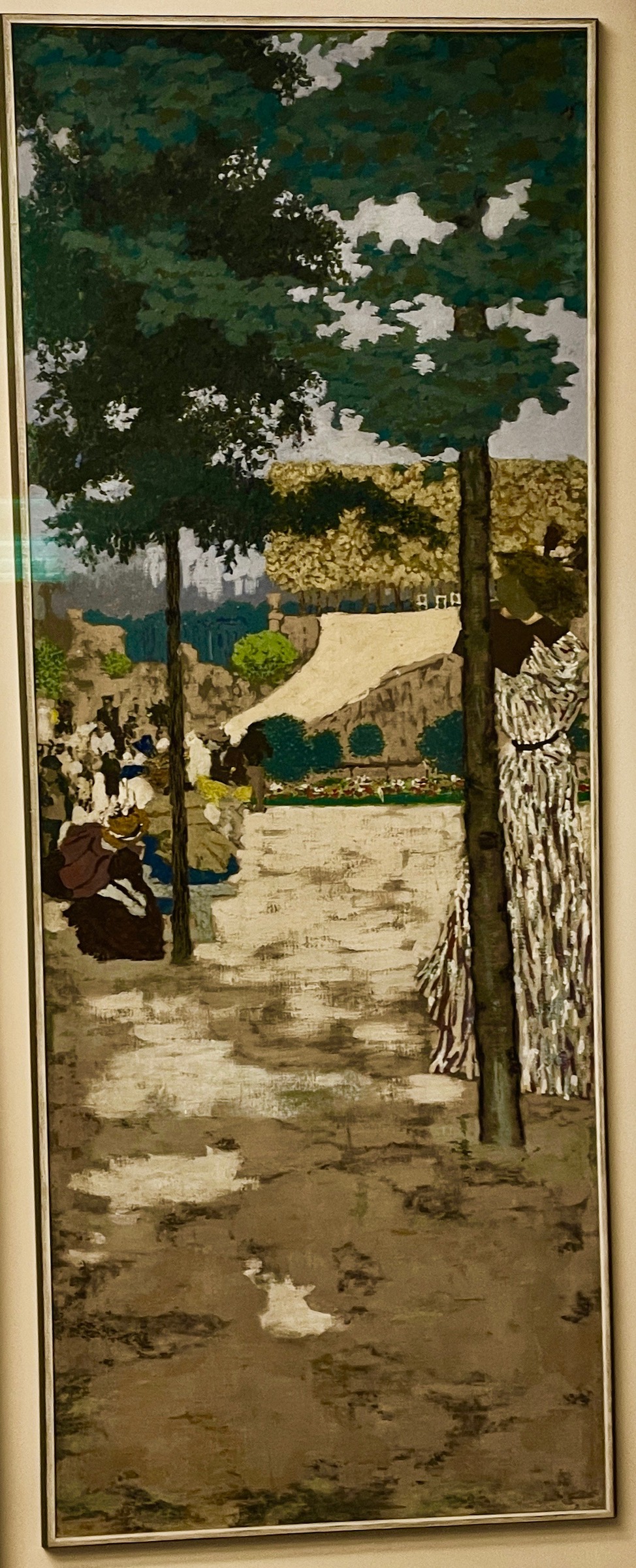
This was my favourite painting of the Rosengart Collection and strangely enough the second time the Tuileries Gardens have come up in this post. Edouard Vuillard was heavily influenced by Japanese print makers and it absolutely shows in this painting which has a lot more depth than comes through in a mere photo.
While that concludes the exploring Lucerne portion of this post I want to include a few restaurant recommendations.
While staying at the Waldstatterhof we had two dinners there that were excellent. One of the real treats I look forward to every time I’m in western Europe in the late spring is white asparagus. There is simply nothing comparable in North America. You can eat it just as it comes.
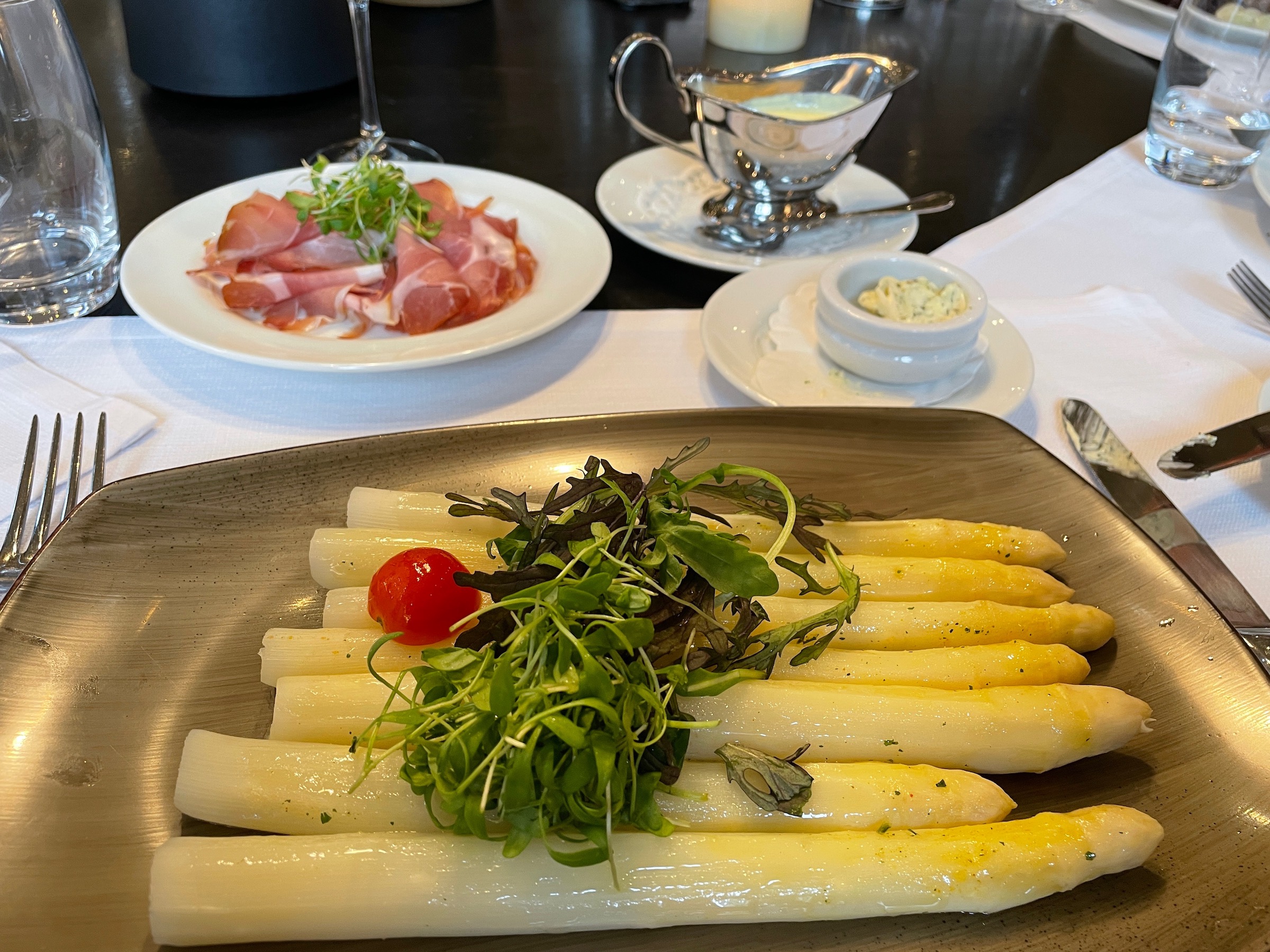
Or add prosciutto and Hollandaise sauce for an epicurean extravaganza.
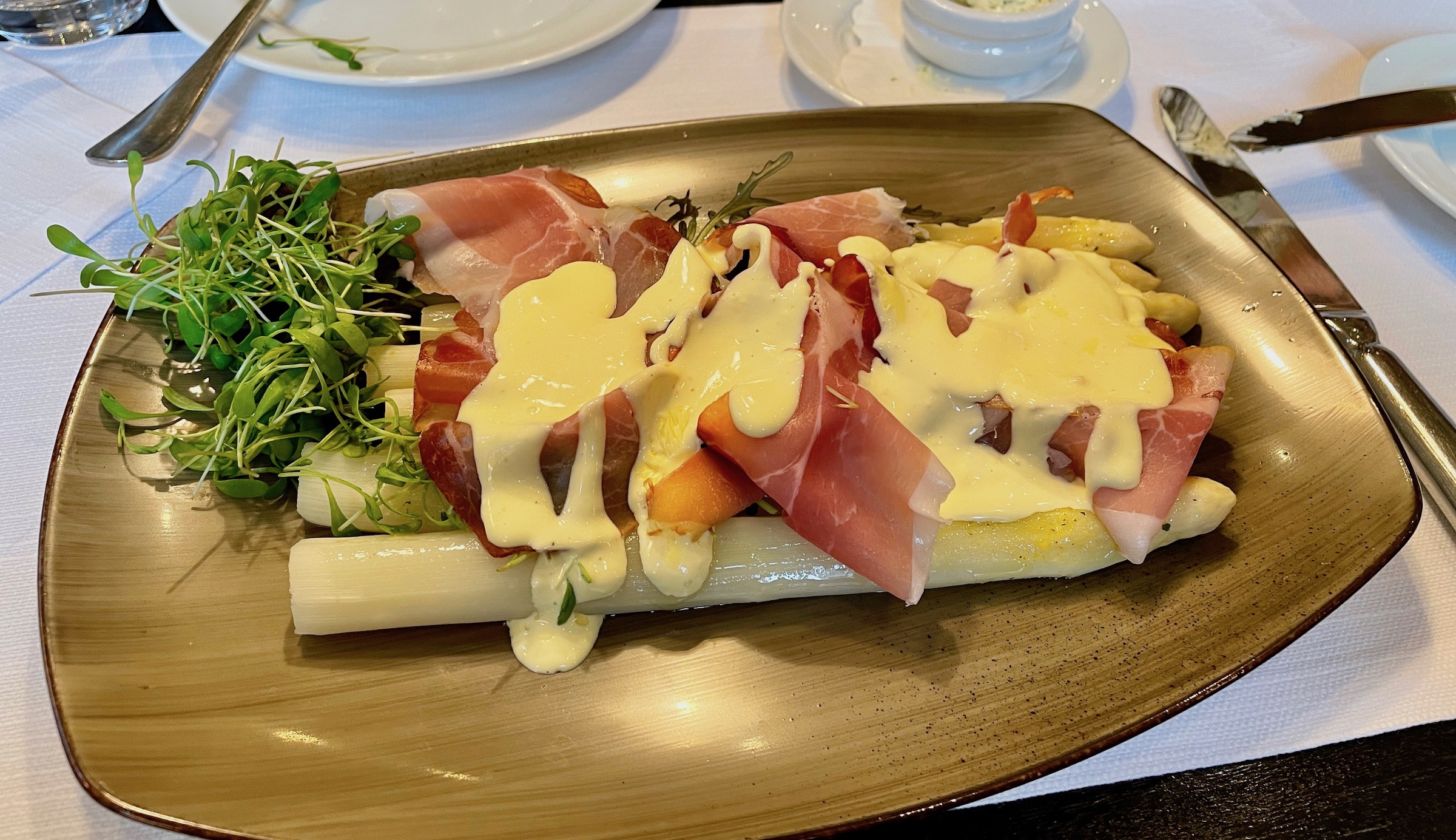
For one meal Alison had the trout saltimbocca over risotto which was excellent.
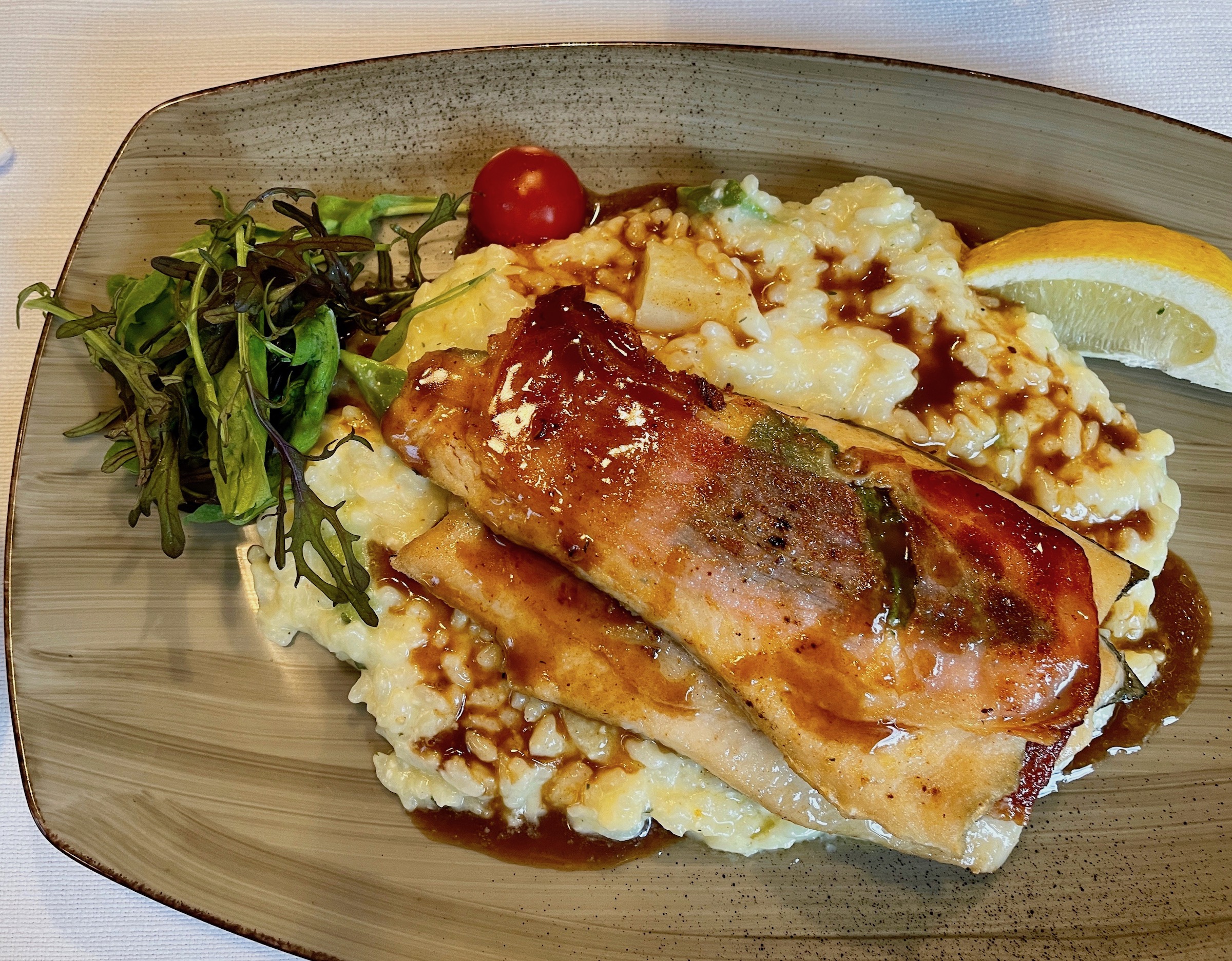
As were the veal escalope.
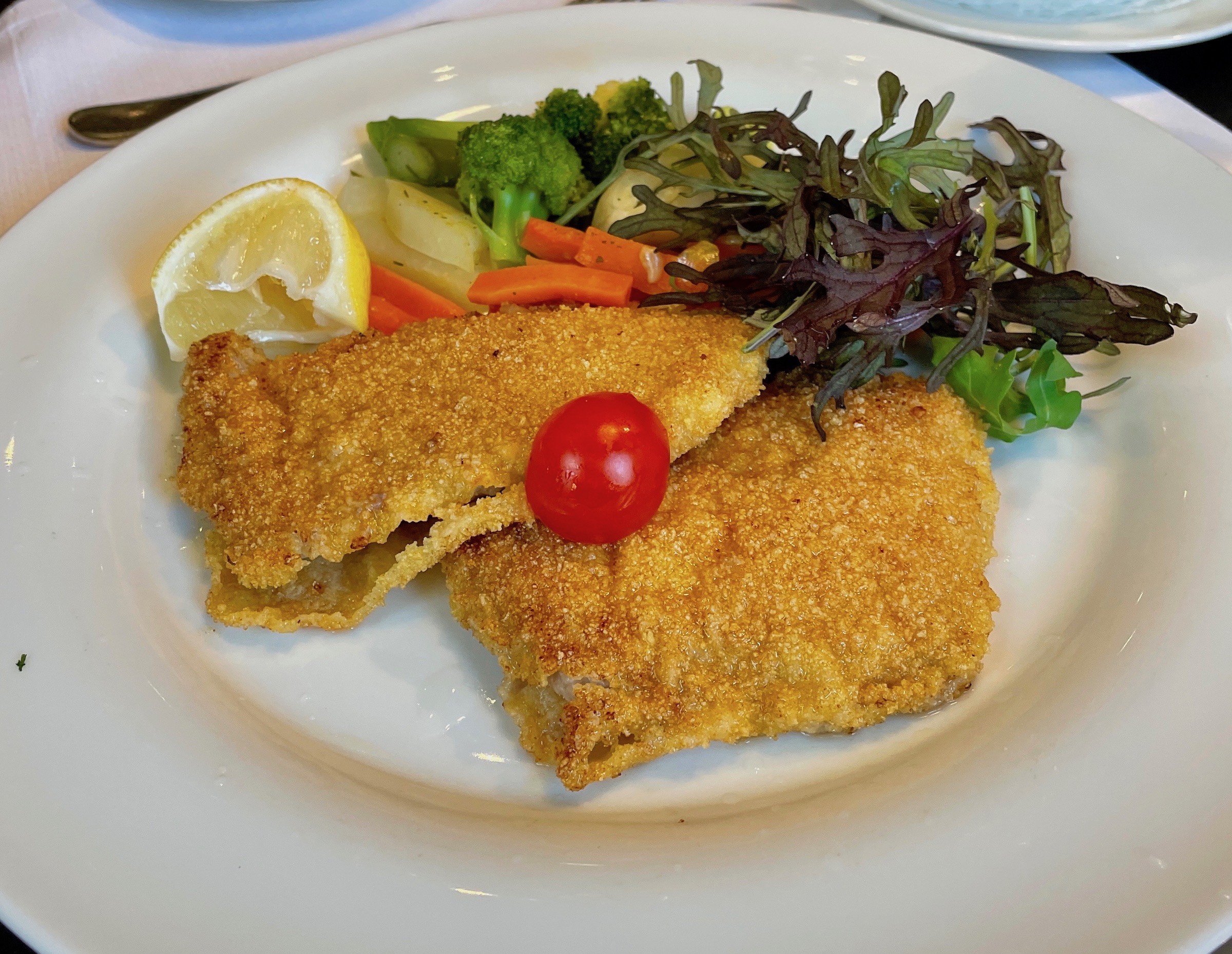
The Swiss make great things from their many dairy products so it’s no surprise that they make great ice cream.
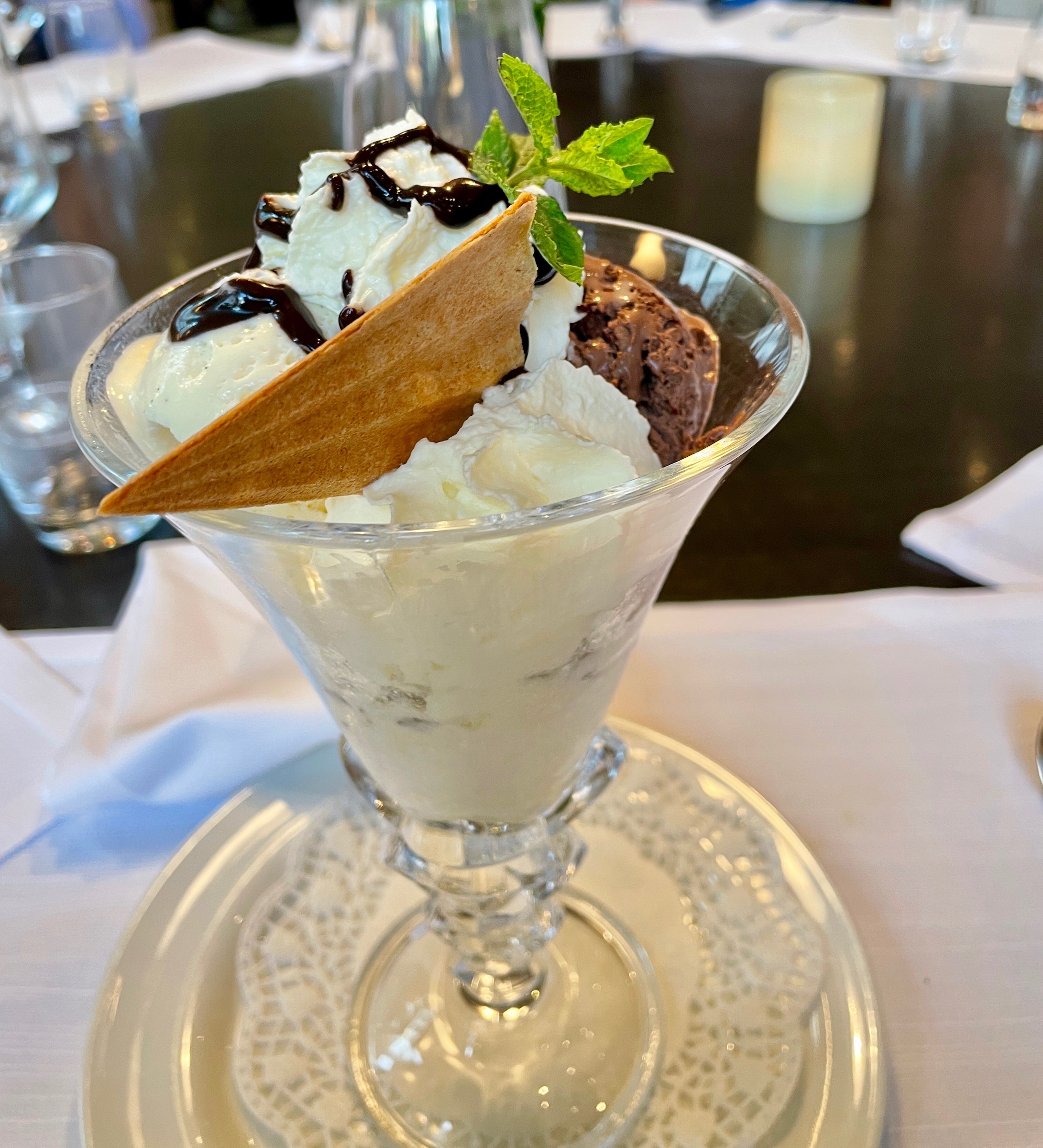
And flan. That’s real whipped cream BTW.
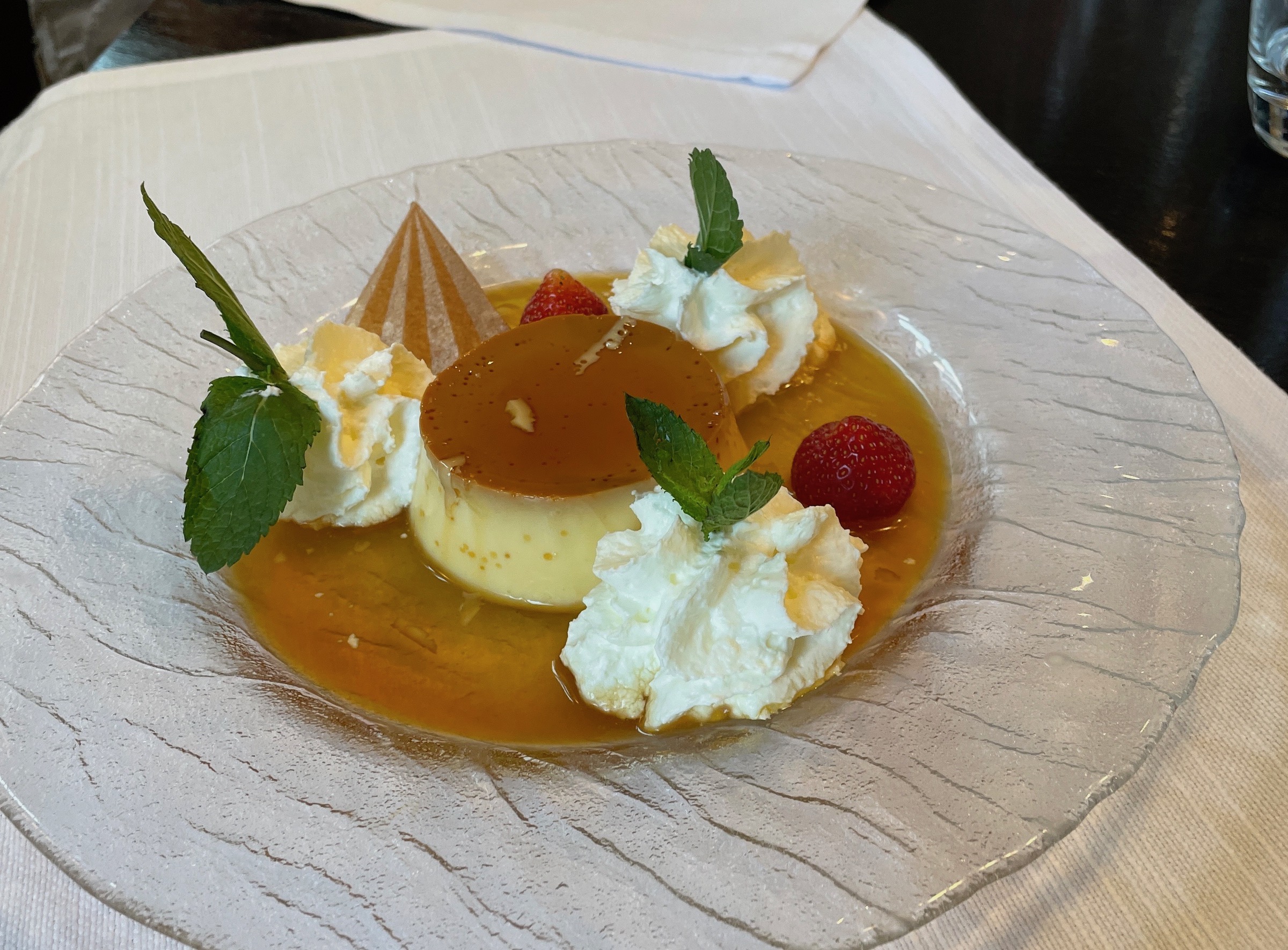
For another meal we had a communal table at the Rathaus Brauerei which not surprisingly given the name is in the portico of the Lucerne Rathaus. There we enjoyed some great beer and roast chicken.

So you will eat pretty well while in the hands of tour guide Victor Romagnoli. However, you will have some meals on your own while exploring Lucerne and you must have one in one of the riverbank cafes on the medieval side of the river. Grab a table by the river and watch the ducks and swans.
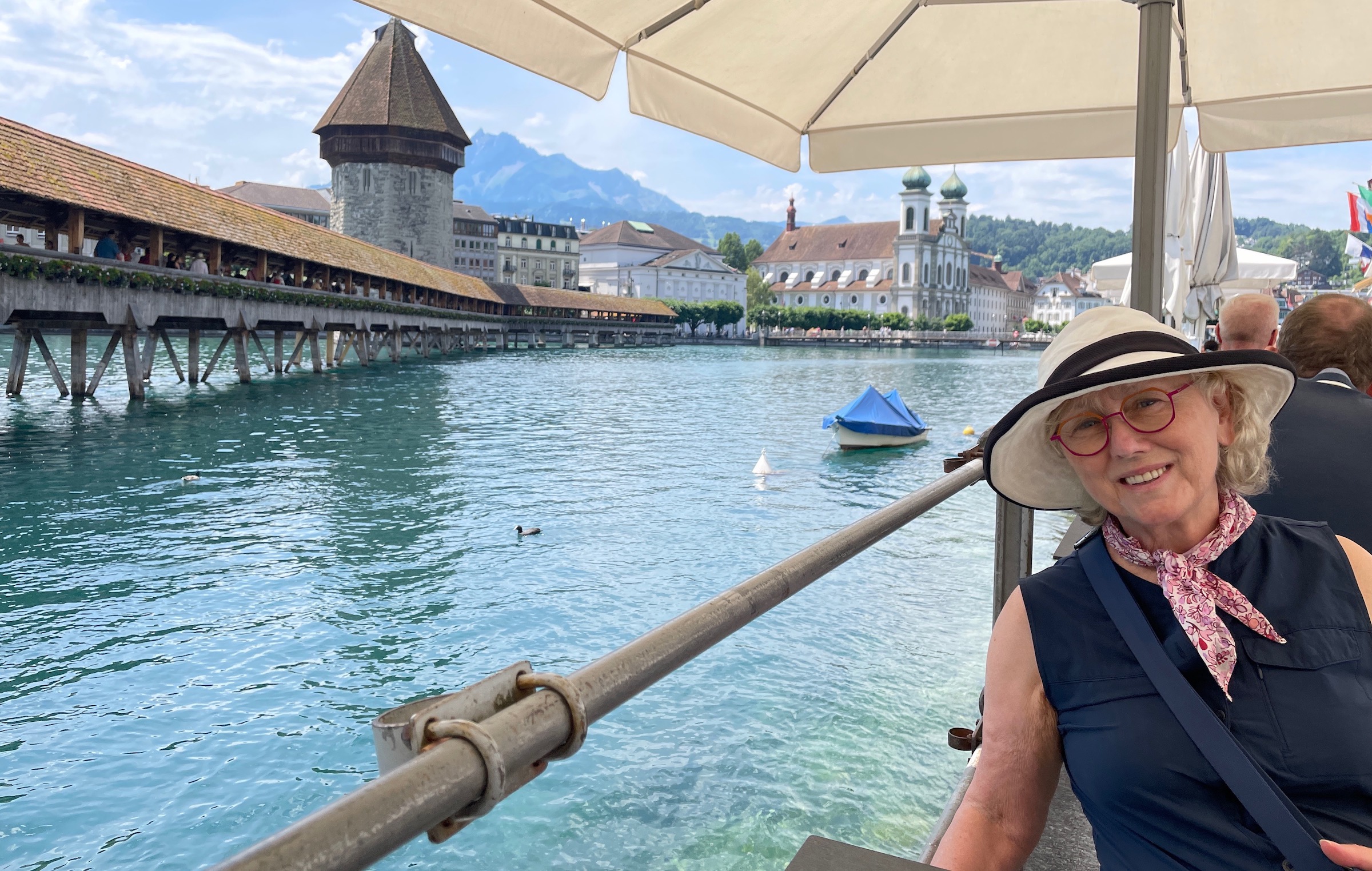
This is the antipasti plate from the Bonne Cave wine bar. I forsook the wine in favour of locally made Mons Gold lager from Kriens Brewery.

Another great place to have a meal is in the nearby Kornmarket Platz which has restaurants all around its periphery. We had some great tapas including some sensational mushroom croquettes at a Spanish restaurant whose name I forgot to write down.
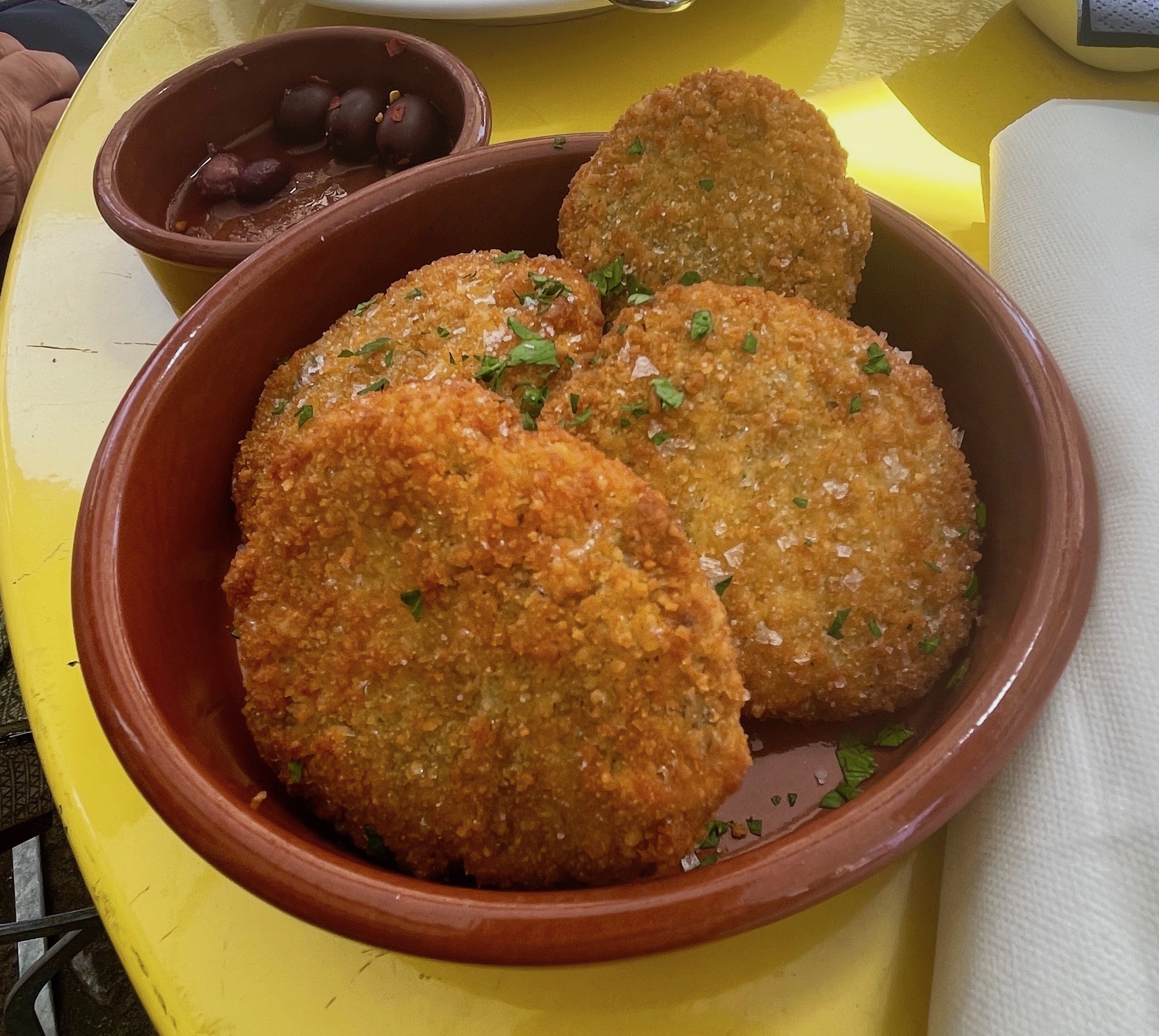
With that admission of failure I’ll wrap up this post on exploring Lucerne and think about our next outing which will take us across Lake Lucerne to Mount Rigi where we will board the oldest funicular railway in the world. I hope to see you on board.

